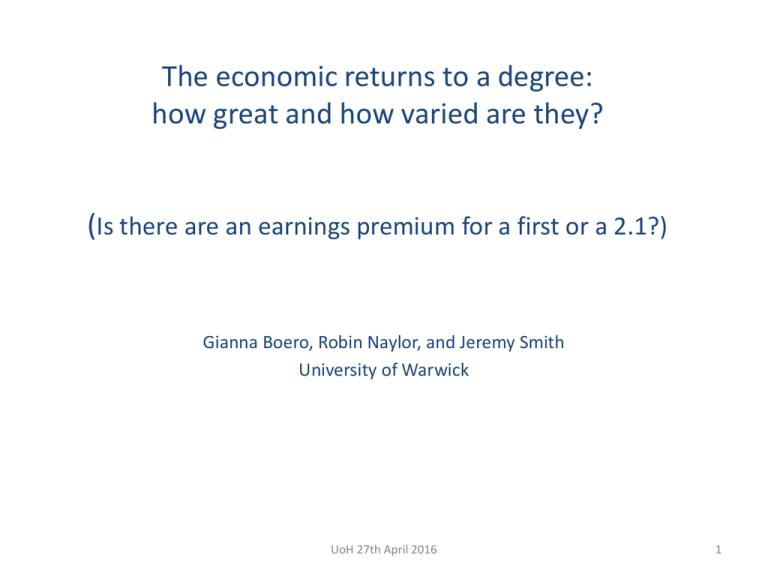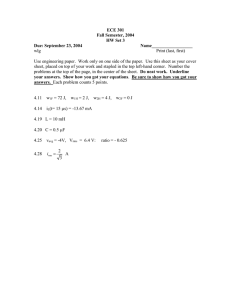The economic returns to a degree: (
advertisement

The economic returns to a degree: how great and how varied are they? (Is there are an earnings premium for a first or a 2.1?) Gianna Boero, Robin Naylor, and Jeremy Smith University of Warwick UoH 27th April 2016 1 Plan of Talk 1. Context 1: Evidence and Policy Context 2: Theory and Interpretation 2. Institutional Arrangements 3. Data and Methodology 4. Results 5. Conclusions and Further Work UoH 27th April 2016 2 Plan of Talk 1. Context 1: Evidence and Policy Importance of HE Human Capital, R&D, Economic Growth HE Participation and Labour Supply Socio-economic Mobility/Persistence Political Economy: fees and funding Returns to Education Years of Schooling Qualification Levels Grades Performance HE Policy relevance of estimated returns in UK Dearing Report and evidence from Blundell et al. (2000: PTO) Browne Report UoH 27th April 2016 3 Average Graduate Premium in UK Blundell et al. (2000): NCDS1958 birth cohort 1991 hourly wage data Estimates ln wi HEi X i i where HE is Highest Educational Qualification Rich set of observable characteristics Assumes that: E ( i | HEi , X i ) E ( i | X i ) Individuals with different HE do not differ on average in unobservables. Results Graduate Earnings Premium (Relative to control group with 2+ A-levels) 17% 37% Men Women UoH 27th April 2016 4 Variation around Average Subject Higher for Science, Social Science (Harkness and Machin, inter alia) Institution Higher for ‘Elite’ HEIs (Chevalier et al., inter al.) Hence Differential Fees (Greenaway and Haynes) Prior Schooling (Naylor and Smith) Cohort Walker and Zhu, 2008 Expansion no effect on average Increased premium in highest quartile (Ability composition effect?) … Degree Class Premia (Not available in NCDS) UoH 27th April 2016 5 Interpretation of Graduate Earnings Premium Human Capital Theory Signalling/Screening/Sorting Theories Statistical Discrimination Short-run only? Employer Learning/Statistical Discrimination UoH 27th April 2016 6 Jo Johnson, Minister of State for Universities and Science, speaking about BIS’s Green Paper ‘Fulfilling our Potential: Teaching Excellence, Social Mobility and Student Choice’, stated that, “We want to encourage a (grade point average) system which provides greater information to employers about where attainment really lies. It needs to sit alongside, rather than replace, the honours degree classification… But there is a very big band, the 2.1 band. It disguises very considerable differences in attainment. You can be at the top of the band and then be 50 percentage points below and still be getting a 2.1. And students who worked hard should be able to signal to employers that’s what they’ve achieved.” (Cited on BBC News website 06/11/2015.) UoH 27th April 2016 8 Degree Class Premia: Evidence from available data BCS70 LFS USR/HESA GCS Background Classification of Honours Degrees: First Upper Second (>=2.1 => ‘Good’) Lower Second (=<2.2 => ‘Lower’) Third Pass (Non-honours) Classification Rules: Based on: Overall average Papers in class Final exams/coursework Viva Anecdotally: ‘Achieves’ vs ‘Is’! = HKT vs Signalling! UoH 27th April 2016 9 Estimated log wage premia (BCS70) (1) (2) (3) (4) (5) Wages observed in year: 2000 2000 2000 2000 2000 Wages observed at age: 30 30 30 30 30 Good degree class premium relative to lower degree class 0.078 (0.007) 0.077 (0.008) 0.073 (0.012) 0.071 (0.014) 0.068 (0.019) Lower degree class premium relative to 2+ A-levels 0.119 (0.000) 0.105 (0.001) 0.107 (0.000) 0.103 (0.001) 0.109 (0.000) Family background No Yes Yes Yes Yes Ability at age 10 No No Yes Yes Yes Ability at age 5 No No No Yes Yes Non-Cognitive ability at ages 5, 10 No No No No Yes Other controls Yes Yes Yes Yes Yes 3046 3046 3046 3046 3046 0.0814 0.0988 0.1029 0.1119 0.1188 No. of Obs R2 Good degree premium over Lower Lower degree premium over Alevels Notes: p-values in parentheses. Ability controls include: BAS (verbal), BAS (numerical). Background controls include: parental income, parental social class, mother’s interest in education, father’s interest in education, mother’s education, father’s education. Other controls include: region (aged 10), gender, marital status and number of children, ethnicity. UoH 27th April 2016 10 Estimated log wage premia (LFS): selected birth cohorts in 1969-1971 Wages observed at: 2005-2012 Wages observed at age: 36-41 Good degree class premium (relative to lower degree class) 0.087 (0.001) 0.188 Lower degree class (0.000) (relative to 2+ A-levels) Yes Other controls No. of Obs 2930 R2 0.152 UoH 27th April 2016 11 Estimated log-earnings premia (USR91, graduate cohort), birth cohort 1969-1971 USR-FDS: First Destination Median Occupational earnings Earnings observed at: 1992 1992 Earnings observed at age: 21-23 21-23 Good degree class premium relative to lower degree class 0.046 (0.000) 0.043 (0.000) Ability and background controls No Yes Other controls Yes Yes No. of Obs. 22,459 22,459 R2 0.334 0.336 Note: p-values in parentheses. Ability controls include: pre-University qualifications. Background controls include: social class of parents, school-type. Other controls include: gender, marital status, University attended and type of degree course. UoH 27th April 2016 12 Estimated log-wage premia (GCS1990, graduate): birth cohort 1968-1970 (1) (2) (3) (4) Wages observed at: 1991 1991 1996 1996 Wages observed at age 21-23 21-23 26-28 26-28 Good degree class premium relative to lower degree class 0.051 (0.014) 0.049 (0.014) 0.084 (0.014) 0.079 (0.014) Ability and background controls No Yes No Yes Other controls Yes Yes Yes Yes No. of Obs 2839 2839 3652 3652 R2 0.127 0.131 0.115 0.119 Note: p-values in parentheses. Ability controls include pre-university qualifications, background controls include parental education, and other controls include age, gender, ethnicity, and marital status. UoH 27th April 2016 13 Figure 5a: Coefficients on degree class variables over time ( constant earnings) - Males 0.08 0.06 0.04 0.02 Coeff 0.00 1985 1986 1987 1988 1989 1990 1991 1992 1993 1994 1995 1996 1997 1998 -0.02 -0.04 -0.06 -0.08 -0.10 -0.12 Year First 2:2 Third UoH 27th April 2016 Other 15 Plan of Talk 1. Context 1: Evidence and Policy Context 2: Theory and Interpretation How might we interpret evidence of a premium by class of degree awarded? Why might any premium by degree class change across cohorts? UoH 27th April 2016 16 Hypothesis 1 Pay But if Econometrician observes only Degree Class, then there appears to be a Premium by Class: might wrongly interpret this as a discontinuity. 280 PAYPROVA 240 200 160 120 80 0 20 40 60 80 100 Average Mark MARK1 UoH 27th April 2016 19 A Regression Discontinuity framework offers the prospect of being able to distinguish between the two hypotheses – but requires us to observe both degree classification and underlying marks. Hypothesis 2 Pay Employer regards Degree Class as a Signal of some dimension of ability. A discontinuity would be indicative of signalling or statistical discrimination in the sense of the EL-SD approach I a Average Mark UoH 27th April 2016 23 Regression discontinuity and degree class effects Also see: di Pietro (2012); Feng and Graetz (2015) We use individual student data on an anonymous university located somewhere near the centre of England… Anonymised DLHE returns for graduate cohorts of 2011/12, 2012/13, 2013/14. Matched by personal id to extensive individual student records. Data include: Age, gender, nationality, fees status, course, department, previous schooling, family background, degree class, marks per module per year. Labour market outcome, 5-digit SOC, SIC, salary, degree class, location… UoH 27th April 2016 30 3. Data and Methodology To date, we have data only for individuals who have responded to the DLHE in each cohort – we are waiting student records on all students in order to establish the extent to which DLHE respondents might differ in observable characteristics from non-respondents. The DLHE response rate is approximately 63%. Results to be presented today exploit data on graduates who are in full-time employment and have provided Research-Accessible personal salary information. The usable response rate to the salary question is approximately 41%. UoH 27th April 2016 34 Population of All Leavers n= 25950 DLHE Respondents n= 16360 (63%) Online/Post n= 6751 (41%) PG n= 3515(52%) Telephone n= 9609 (59%) UG n= 3265 (48%) FT-Employed n= 1691 (52%) Further Study n= 931 (29%) OLFU n= 6751 (19%) Salary Data n= 1404 (83%) UoH 27th April 2016 36 UG Students. Degree Class breakdown by: All DLHE Respondents, FT-Emp, Salary Info Degree DLHE In FT Salary Class Resp Emp Info -------------------------------------------------1st 35% 34% 35% 2:1 53% 54% 53% 2:2 11% 11% 11% 3rd 2% 2% 2% -------------------------------------------------n 3265 1691 UoH 27th April 2016 1404 38 UG n= 3265 UG HEU+3/4-yr+08-11start n= 2791 FT-Employed n= 1691 (52%) FT-Employed n= 1517 (54%) Salary Data n= 1404 (83%) Salary Data n= 1292 (85%) Analysis will be based on a sample which excludes OS students, any students starting later than 11/12 and any students on UG degrees other than 3 or 4 year duration. UoH 27th April 2016 40 Probability of receiving Treatment (= Good degree) Cut-off at 60 All UGs in responding to DLHE online/post: (except: OS, course duration ~=3|4) Scatter Plot: Bins=30 0 .2 .4 good .6 .8 1 Based on n=2705 50 60 70 overall_ave UoH 27th April 2016 80 90 41 Probability of receiving Treatment (= First) Cut-off at 70 All UGs in responding to DLHE online/post: (except: OS, course duration ~=3|4) Scatter Plot: Bins=30 0 .2 .4 first .6 .8 1 n=2705 50 60 70 overall_ave UoH 27th April 2016 80 90 43 Compliers and Non-compliers All: 2.1 versus 2.2 n=1707: Compliers=92% 2.2 2.1 <60 281 136 All: 1st versus 2.1 n=2422: Compliers=89% >=60 2 1288 2.1 1 Science: 2.1 versus 2.2 n=751 : Compliers=94% <60 >=60 2.2 201 1 2.1 46 503 UoH 27th April 2016 <70 1422 272 >=70 2 726 Science: 1st versus 2.1 n=1091 : Compliers=90% <70 >=70 2.1 548 1 1 107 435 45 10 8 Percent 6 4 2 0 8 9 10 lannualpay 11 12 Density of log(annual pay)) UoH 27th April 2016 47 9.5 10 10.5 RD Plot: cutoff=60 40 60 Sample average within bin 80 100 4th order global polynomial Data-driven RD plots See Calonico, Catteneo and Titunik (2014) Bin scatter plot of log(annual pay) versus Overall Average Mark All Cut-off 60 n=1193 UoH 27th April 2016 49 9.7 9.8 9.9 10 10.1 10.2 RD Plot: cutoff=60 50 55 60 Sample average within bin 65 70 4th order global polynomial Data-driven RD plots See Calonico, Catteneo and Titunik (2014) Bin scatter plot of log(annual pay) versus Overall Average Mark Science Cut-off 60 n=646 UoH 27th April 2016 51 9.8 10 10.2 10.4 RD Plot: cutoff=70 50 60 Sample average within bin 70 80 90 4th order global polynomial Data-driven RD plots See Calonico, Catteneo and Titunik (2014) Bin scatter plot of log(annual pay) versus Overall Average Mark IMSE-optimal evenly spaced method using polynomial regression (espr) All Cut-off 70 n=1193 UoH 27th April 2016 52 9.8 10 10.2 10.4 RD Plot: cutoff=70 50 60 Sample average within bin 70 80 90 4th order global polynomial Data-driven RD plots See Calonico, Catteneo and Titunik (2014) Bin scatter plot of log(annual pay) versus Overall Average Mark IMSE-optimal quantile-spaced method using spacings estimators (qs) Science Cut-off 70 n=646 UoH 27th April 2016 53 -.5 0 .5 1 RD Plot: cutoff=60 40 60 Sample average within bin 80 100 2th order global polynomial Continuity (Gender) (RDPLOT) All P(2) UoH 27th April 2016 54 -.5 0 .5 1 RD Plot: cutoff=60 40 60 80 Sample average within bin 100 4th order global polynomial Continuity (FT-Employment) Cut-off 60 (RDPLOT) ALL P(4) UoH 27th April 2016 56 0 .2 .4 .6 .8 RD Plot: cutoff=70 40 60 Sample average within bin 80 100 4th order global polynomial Continuity (FT-Employment) Cut-off 70 (RDPLOT) ALL P(4) UoH 27th April 2016 58 0 .5 1 RD Plot: cutoff=70 40 60 Sample average within bin 80 100 4th order global polynomial Continuity (FS) Cut-off 70 (RDPLOT) ALL P(4) UoH 27th April 2016 59 3. Data and Methodology Issue of manipulation/precision of control over assignment variable Student manipulation: Those on track for ‘borderline’ after Year 2 work hard to achieve 2.1, those below borderline reduce effort. So we’d see a trough in the density distribution. Note: manipulation of overall average much harder than of a single module Marker manipulation: Eg practice of avoiding ‘9s’ Exam Board manipulation: If Board uses ‘unobservable’ knowledge insight/rules/discretion which correctly assign individuals to treatment/control groups. “This person is a 2.1” UoH 27th April 2016 60 8 6 Percent 4 2 0 40 60 80 100 overall_ave Density of Overall Average Mark All n=3210 UoH 27th April 2016 61 Plan of Talk 1. Context 1: Evidence and Policy Context 2: Theory and Interpretation 2. Institutional Arrangements 3. Data and Methodology 4. Results 5. Conclusions and Further Work UoH 27th April 2016 63 IV (2SLS): log(annual pay) on 2:1 Treatment ALL (2:1 vs 2:2) (Same as previous estimation: but excluding cases of 3rds/1sts in borderlines) Total (centered) SS Total (uncentered) SS Residual SS = = = 113.6869721 73125.38036 104.6405362 Number of obs F( 6, 724) Prob > F Centered R2 Uncentered R2 Root MSE = = = = = = 731 10.89 0.0000 0.0796 0.9986 .3783 ------------------------------------------------------------------------------| Robust lannualpay | Coef. Std. Err. z P>|z| [95% Conf. Interval] --------------+---------------------------------------------------------------Upper Second | .1453312 .1657892 0.88 0.381 -.1796097 .4702722 overall_ave60 | .0027592 .0099878 0.28 0.782 -.0168166 .022335 female | -.1942985 .0288996 -6.72 0.000 -.2509408 -.1376563 startyr_e | -.0938844 .0470748 -1.99 0.046 -.1861493 -.0016194 startyr_1 | .0648903 .0445951 1.46 0.146 -.0225145 .1522952 startyr_3 | -.0514248 .045259 -1.14 0.256 -.1401308 .0372811 _cons | 10.01462 .1180723 84.82 0.000 9.783199 10.24603 ------------------------------------------------------------------------------- So the cases of 1sts in the top borderline was driving an apparent effect of 2:1s (given a discontinuity around 70). 48=< Overall Average Mark <70 UoH 27th April 2016 67 IV (2SLS): log(annual pay) on 2:1 Treatment Science (2:1 vs 2:2) Second Stage regression Total (centered) SS Total (uncentered) SS Residual SS = = = 44.13720296 34613.63128 40.36358091 Number of obs F( 3, 341) Prob > F Centered R2 Uncentered R2 Root MSE = = = = = = 345 9.42 0.0000 0.0855 0.9988 .342 -----------------------------------------------------------------------------| Robust lannualpay | Coef. Std. Err. z P>|z| [95% Conf. Interval] -------------+---------------------------------------------------------------Upper Second | .2742169 .1543015 1.78 0.076 -.0282084 .5766422 overall_ave | -.0067806 .0109202 -0.62 0.535 -.0281838 .0146226 female | -.1356737 .0379965 -3.57 0.000 -.2101455 -.061202 _cons | 10.26969 .5676385 18.09 0.000 9.157143 11.38224 ------------------------------------------------------------------------------ For First Stage regression see next slide 48=< Overall Average Mark <70 UoH 27th April 2016 68 IV (2SLS): log(annual pay) on 1st Class Degree Treatment ALL (1st vs 2:1) Total (centered) SS Total (uncentered) SS Residual SS = = = 165.4780731 106057.3973 138.081668 Number of obs F( 9, 1037) Prob > F Centered R2 Uncentered R2 Root MSE = = = = = = 1047 25.15 0.0000 0.1656 0.9987 .3632 -------------------------------------------------------------------------------| Robust lannualpay | Coef. Std. Err. z P>|z| [95% Conf. Interval] ---------------+---------------------------------------------------------------first | .1586433 .0730816 2.17 0.030 .0154059 .3018806 overall_ave70 | -.018867 .0116393 -1.62 0.105 -.0416795 .0039456 overall_ave70*d| .0428893 .0189292 2.27 0.023 .0057886 .0799899 overall_ave702 | -.0008714 .0005818 -1.50 0.134 -.0020117 .0002689 female | -.1295679 .0245841 -5.27 0.000 -.1777518 -.081384 sci | .2427035 .0340108 7.14 0.000 .1760436 .3093634 ssci | .3220823 .0371857 8.66 0.000 .2491997 .394965 startyr_3 | -.0268086 .0243803 -1.10 0.272 -.0745931 .020976 startyr_4 | .0312276 .036926 0.85 0.398 -.041146 .1036011 _cons | 9.774553 .0701673 139.30 0.000 9.637027 9.912078 -------------------------------------------------------------------------------- 58=< Overall Average Mark UoH 27th April 2016 70 IV (2SLS): log(annual pay) on 1st Treatment Science (1st vs 2:1) Total (centered) SS Total (uncentered) SS Residual SS = = = 60.61066027 55388.29596 54.67445708 Number of obs F( 6, 533) Prob > F Centered R2 Uncentered R2 Root MSE = = = = = = 540 10.93 0.0000 0.0979 0.9990 .3182 -------------------------------------------------------------------------------| Robust lannualpay | Coef. Std. Err. z P>|z| [95% Conf. Interval] ---------------+---------------------------------------------------------------first | .2181923 .1039298 2.10 0.036 .0144936 .4218909 overall_ave70 | -.022705 .0135287 -1.68 0.093 -.0492208 .0038107 overall_ave70*d| .0378093 .0197661 1.91 0.056 -.0009314 .0765501 overall_ave702 | -.0003334 .0005811 -0.57 0.566 -.0014724 .0008056 female | -.139969 .0302722 -4.62 0.000 -.1993014 -.0806366 startyr_e | .0488098 .0276974 1.76 0.078 -.0054761 .1030957 _cons | 9.942504 .0871684 114.06 0.000 9.771657 10.11335 -------------------------------------------------------------------------------- Consistent with RD for 60 < Overall Average Mark < 70 58=< Overall Average Mark UoH 27th April 2016 71 5. Conclusions and Further Work (i) (Fuzzy) RD to estimate causal effect of degree class on earnings (ii) Evidence of Signalling in early careers Upper Second Class Premium For Science only: 27% First Class Premium on average: 16% Strongest for Science: 22% (iii) Other findings Large negative female intercept Premia for Science and Social Science over Arts/Humanities (iv) Further Work/Data 4-digit SOC average occupational earnings Telephone Responses More cohorts 3 ½ year follow-up HMRC link => Non-parametric results UoH 27th April 2016 73



